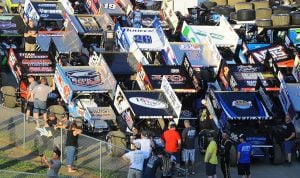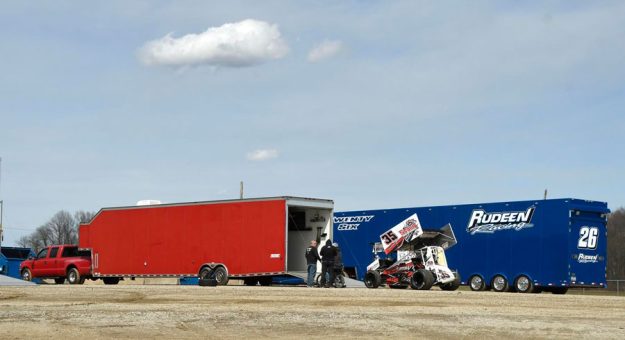As if the tire shortage hasn’t hampered the auto racing industry enough, record gas prices have also been an issue with no end in sight.
The United States set a record for the highest national average at $4.60 per gallon of regular unleaded only a couple of days before Memorial Day Weekend. A week prior, diesel fuel reached its highest national average at the time of $5.577.
One year ago in May, the national average was $3.041 per gallon of regular unleaded and $3.179 per gallon of diesel, according to AAA.
Analysts have used words such as cruel and devastating to describe how much tougher this summer will get as $6 per gallon of regular unleaded gas has been predicted.
Residual effects from the COVID-19 pandemic and lockdown, ramifications from the war between Russia and Ukraine, politics and flat-out greed have all been blamed as catalysts for the record hike in gas prices.
Regardless of the circumstances that have come together to cause the dramatic fuel-price increase, the impact is felt within households throughout the country.

“It’s been harder on the fans than the race teams so far,” said Doug Johnson, the general manager at Huset’s Speedway in Brandon, S.D., and Jackson Motorplex in Jackson, Minn. “That might change next week. We’ve seen less fans because of gas prices because they have the option to stay home and watch. The race teams are going to continue to go. If it increases more and more, then we’ll definitely have teams picking and choosing where they end up racing.
“Racers are going to race. If you give the fans any reason to stay home and watch they will. That has us more concerned.”
Three-time reigning World of Outlaws NOS Energy Drink Sprint Car Series champion Brad Sweet fields a full-time merchandise trailer and has felt the effects of higher fuel prices.
“When you set budgets and things, it’s hard to know that something like that will happen,” he said. “It puts a lot of pressure on your budget. Some of these teams run very lean, race to race, and winnings are a big part of it. You add in rainouts, a 50 percent jump in gas prices, overall food costs for the crew guys, the tire shortage plus the cost of tires. It’s safe to say everyone is struggling pretty bad. It’s been a difficult start to 2022.
“We’re seeing it in our sales being down. Our costs are up and our sales are down,” Sweet said. “Disposable income is getting less and less. The average fan’s money left over to buy a T-shirt isn’t there. I think we’ll struggle as the season goes on with butts in the seats.”
World of Outlaws veteran Jason Sides noted that he expects his diesel bill for the season will be at least double last year’s cost. While Sides, Sweet and others are committed to traveling the country on the World of Outlaws circuit, Gio Scelzi’s true outlaw schedule has been impacted.
“I’d say it has affected us,” he said. “I bought a T-shirt van. I spent $300 in diesel just going to Knoxville and Huset’s. If I make $700 a night, half of it goes to my fuel bill.
“Luckily for us, Knoxville is an hour away. Going to Pennsylvania is every bit of 15 hours,” Scelzi said. “Driving a semi up and down the road is a high cost. Everything — including hotel bills — is more expensive. Our partners understand that to do it the right way it costs more right now.
“They are seeing it in their businesses because they are in construction. They are seeing the increases in diesel bills. I don’t think it’d affect us to not go racing, but it does affect the decision on where to go.”
Johnson has heard from drivers who have reached out stating they want to race an event at Huset’s Speedway or Jackson Motorplex, but the high gas costs have kept them from traveling.
“Last week we gave away $100 gas cards in a random draw at our pit meeting to help out race teams,” he said in May. “We’re prepared to implement more and more down the road.
“I think it’s on top of the awareness for all of us. We have to be cognizant of what’s going on. It’s a two-fold deal. We have to be very aware of the fuel prices and the tire shortage. It has potential to really hurt the sport. I think as an industry we have to be on top of it and do what’s best for everybody.
“But if you start calling races because it looks like it might rain you’ll tick off your sponsors and suite holders. It’s a fine line. You have to keep a respectful mind of the racers, but on the flip side we have sponsors and suite holders to take into consideration. It’s a lot of moving parts.”
Also, there are push-truck drivers helping out each weekend across the country. Not only is there gas to drive to and from the track, fuel is also used while pushing off race cars and packing the track at some facilities.
Johnson said Huset’s Speedway and Jackson Motorplex compensate push-truck drivers each night, plus offer an incentive at the end of the season for perfect attendance.
World Racing Group CEO Brian Carter is concerned about the direction of the increasing fuel costs.
“The fuel prices are a significant expense for us with all the trucks and trailers,” he said. “Any of the race teams, you multiple the fuel bill by five. It’s a concern and you want to be smart about things. You see people being more aggressive with cancellations because of forecasts. If we can avoid an expense, we’ll try to avoid that. It’s a difficult balance.
“Even back to 2008 and the pandemic, we’re a local entertainment. We spend money to come to the fans,” Carter continued. “Most of our events have been well attended this year. You have to be cognizant of all the issues and the fuel is one of them this year.
“Our budgets fluctuate because of rain and the other various adjustments. Our fuel bills right now are up 35 or 40 percent on what we’ve spent in the past. Those start to sting in the tens of thousands a week.”
Carter said there are 47 trucks and trailers on the road between the company’s entities — the World of Outlaws NOS Energy Drink Sprint Car Series, the World of Outlaws CASE Construction Equipment Late Model Series, the Super DIRTcar Series big-block modifieds, DIRTcar Racing and DIRTVision.
“It’s the worst I’ve ever seen it at the time we’ve put more equipment on the road than we ever have,” he said. “It’s a double whammy. We’ve continued to add to the fleet. A command center, tech, merchandise, DIRTVision, fan engagement. These are serious logistics to get to the race track.
“It is a cost and it is what it is for the series, but we’re going to be very cautious as we look at early cancellations if we can avoid travel. We are cognizant of the fuel and how much the budget is for everybody that is traveling. We are very, very aware of it as we always have been.”
As gas costs continue to rise, Sweet noted he might have to decide whether it makes sense to have a merchandise trailer at every World of Outlaws event.
“From airline ticket costs to hotel rooms being more money to the diesel prices to get the merchandise trailer up and down the road, everything’s hiked up,” he said. “It’s not like if you spend more you make more. Everyone’s costs have gone up. You’re getting to the point from a merchandise trailer standpoint it’s not at times worth our while financially. It may be more feasible to focus on the big races to take some of the costs out of it. That hasn’t been discussed at this point (in May).”
Tracks and series are concerned that fans and racers will be unable to attend events in the second half of the season if gas prices continue to rise. However, after COVID-19 cancellations impacted the sport the last two years, perspective suggests this is a hurdle that can and will be cleared, Sweet said.
“Racers are resilient,” he added. “They are able to adapt on the fly a lot. It’s not always going to be great and there’s worse things than us struggling with our T-shirt trailers. We don’t want to sound insensitive when we talk about whether we have races or not. There’s a bigger picture.
“It’s different times. You have to adapt with the times. There are a lot of layers to it all.”
